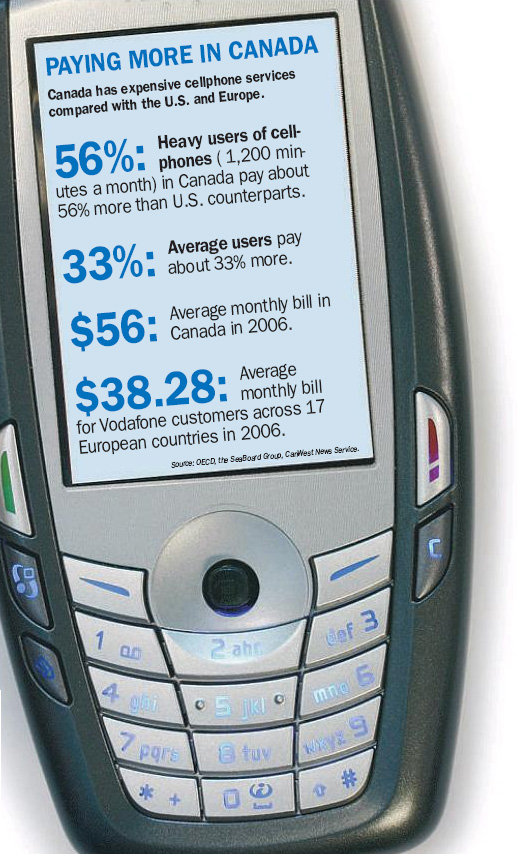Officials will open space for possible fourth national carrier
Derrick Penner, David George-Cosh and Barbara Shecter
Sun

News Service. Group, CanWest the SeaBoard Source: OECD
The federal government on Wednesday set aside a block of wireless-telephone space for a possible fourth national carrier to get into the market and bring more competition to cellphone rates.
Industry Canada has set aside 40 megahertz of the 105 megahertz of new wireless airwaves that it plans to auction off on May 27 for companies with less than 10 per cent of the national wireless market.
“The Canadian wireless market is dominated by three companies that provide services across the country and control 95 per cent of the market,” Industry Minister Jim Prentice told reporters Wednesday in Toronto.
As well, the incumbent carriers — Bell Canada, Rogers Communications Inc., and Telus Corp. –must allow any new entrants that purchase enough spectrum to qualify as a national player to use their networks of cellular towers for roaming.
“This is an opportunity to encourage new market entry,” he added. “It is an opportunity to encourage service providers to offer better products, better service and lower prices.”
The spectrum auction details will undoubtedly widen the chasm between the three national telecom firms and smaller regional players that have pressured the government to make it easier for them to enter the mobile market.
“We’re deeply disappointed,” said Michael Hennessy, vice-president of wireless, broadband and content policy at Telus Corp.
He said favouring new entrants will simply allow smaller, less financially viable competitors into the market, and they won’t be able to compete.
Hennessy said blocking the companies most able to pay for the new airwaves, known as spectrum, will mean that Ottawa receives less revenue for the airwaves. He estimated the auction would raise an additional $200 million if it wasn’t restricted. That amount, he said, amounts to a subsidy to the new firms.
He added that likely new entrants to the market, such as printing giant Quebecor Inc. and Western cable firm Shaw Communications Inc. shouldn’t need help entering the market.
Canada has been criticized as having some of the highest cell-phone rates in the world.
However, Hennessy countered that Industry Canada is using “selective information” to back its policy decision while ignoring other studies that show Canada has lower prices than countries such as the United Kingdom, France and Japan when it comes to voice services.
Hennessy said Canadians who are big users of wireless data service do pay higher prices than similar users in the U.S., but prices are coming down.
He said Canada needs a bigger-scale market if it is to dramatically reduce phone rates, either by allowing consolidation or allowing more foreign ownership.
“The idea, and Industry Canada seems to have a love affair with this idea, that you can create smaller companies in the Canadian market and somehow expect the Canadian market to be more globally competitive, I think, is naive, and in the long run, dangerous,” Hennessy said.
Bell Canada executive vice-president Lawson Hunter said he was “surprised and disappointed” with the announcement.
“It is one of the most regulatory and intrusive spectrum auctions in Canada,” Hunter said, adding the amount of spectrum set aside for new players will not be enough for bandwidth-intensive services to function effectively for consumers if they are on a smaller regional player.
SeaBoard Group managing director Iain Grant, whose report on high wireless prices in Canada was cited by the ministry, dismissed Hunter’s idea that there would not be enough spectrum allocated for all players to cram all their bandwidth-rich programs into.
“New entrants will run out of spectrum, but that’s tomorrow’s problem,” he said. “They’re going to at least be happy with what they can get and move on from there.”
“Mr. Prentice has done a heroic job of plowing through impartial truths to get to the heart of the matter,” said Grant.
However, telecommunications consultant Eamon Hoey, with the firm Hoey Associates, who was a proponent of allowing the restricted auction, said Prentice’s decision didn’t go far enough and puts up barriers against possible new entrants.
Hoey said the entire block of new spectrum should have been set aside for new entrants, and Industry Canada should have set terms for new firms to access the incumbents’ cellular towers while building their own networks.
Instead, Prentice said it will be up to incumbent companies and new firms to negotiate fair rates for tower access and roaming fees, with an arbitration process to handle disputes. “[Disputes] will go to arbitration, and it will be a long zoo,” Hoey said.
“What Industry Canada has done is advanced [potential competition] one yard on a 110-yard field,” Hoey said.
Quebecor, Shaw, and Manitoba Telecom Services have all been named as potential new entrants.
Quebecor has said openly it wants to build a network in the province of Quebec. Shaw, meanwhile, said in late October it has no current plans to enter wireless.
MTS said earlier this month that, while it sees value in creating a fourth national wireless company, it will not decide whether to go ahead until it sees the auction rules.

